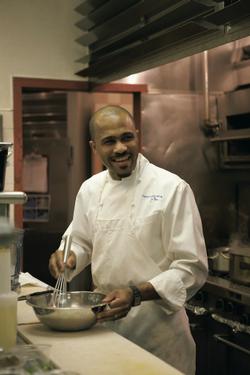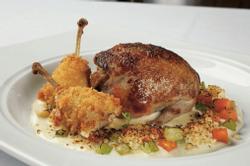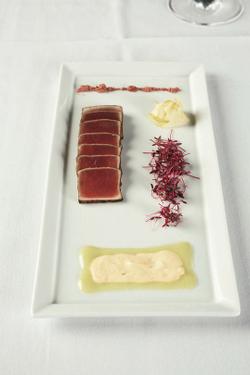
Photograph by Kathryn Norwood.
In the post–9/11 world, many restaurants have been unable to resist the reassuring certainties of comfort food. Not Farrah Olivia. The place risks, and risks big. I would sooner expect to find deconstructed Big Macs at Mickey D’s than I would mac-and-cheese at this new Alexandria restaurant.
The juxtaposition of ingredients is so challenging and the arrangements so unusual that you’re apt to spend much of your meal playing culinary sleuth with your tablemates—“Does anyone taste anise in here?”—or insisting that your server repeat the ingredients list one more time.
“Mustard powder?” I asked a waiter over dessert one night, wondering how a pungent white dust could have found its way into a dish of French toast with blackberry sauce.
“Mustard powder,” he replied. “I don’t make it up. I just serve it.”

The one making it up is Morou Ouattara, a chef who has never been content simply to cook food. He wants to play with it—and to play with your preconceptions about what a meal is and isn’t.
At Mark Miller’s Red Sage in the late 1990s, he reshaped the Southwestern fantasia theme according to his own whims; it was as if a mad scientist had been turned loose in the kitchen to fashion edible architecture. A friend still talks about a plate of roasted squab—a single curled claw raised high above the body in salute—with a swirl of burnt-banana jus we ate one night. Like a lot of Ouattara’s dishes, it sounded wholly improbable but convinced you of its own crazy logic the more you ate.
Ouattara’s next stop was Signatures, the power-dining den of owner/lobbyist Jack Abramoff. Even before scandal engulfed the restaurant, politics, not food, was the focus. Forced to curtail his experimental tendencies for a meat-and-potatoes crowd of lawmakers and lobbyists, Ouattara innovated on the margins, piling shaved bonito flakes along the rim of a plate of grilled calamari. The pinkish mound often came back to the kitchen untouched, but diners who thought to drag a ringlet of squid through the wispy flakes turned a familiar dish into something odd and memorable.
Watching Ouattara at Signatures was a little like watching a talented filmmaker turning out commercials, the brilliance of his work confined to discrete bursts. His followers wondered what would happen if he could wrest himself from working for a chef/owner with a concept, or pleasing an audience antithetical to his aims, and could instead cook for a small crowd of enthusiasts focused on the beguiling push-and-pull of his dishes. The assumption was that with a place of his own, those bursts would be sustained, and the freewheeling talent would mature into something consistent and original.
So far, at least, that appears to have been wishful thinking.
The reason, I think, is partly because Ouattara’s cooking is the equivalent of inspired playground basketball, in which dazzling play is punctuated by moments of raggedness, and partly because this is his first time around as boss, and the young place is still finding its level. Service problems, pacing problems, and inconsistencies in the kitchen all dogged the operation over the course of several visits.
Still, the cooking has a way of lodging in your memory.

One night Ouattara fashioned a filet of salmon into a loin, wrapped it in caul fat—a technique meant to retain the juice of a piece of meat—seasoned it with ground anise, and slow-roasted it to a soft pink lusciousness. He paired it with a toasted couscous made from yucca spiced with candied ginger and a sauce of “refried” tomatoes, which had the intensity and smoky sweetness of sun-dried tomatoes.
Those same refried tomatoes turned up in a simpler construction, as the sauce for a plate of black-eyed-pea fritters. If you asked a Moroccan chef to come up with a hush-puppy tagine, it might taste something like this.
A hanger steak tartare looked like any other Modern American version of the dish—two turrets of raw beef surrounded by a mound of grated radish and quail egg. The inclusion of berbere oil signaled that Ouattara’s inspiration actually was Ethiopia, with its berbere-spiked kitfo.
The invocation of Africa is subtle but unmistakable in these dishes, just as it is in the polished coconut shells that dangle from the ceiling and the stencil work on the walls that evokes the African bush.
Born and raised in Ivory Coast, Ouattara was one of 33 children and had learned to skin and butcher goats by the time kids here learn the times tables. He came to the United States to become a computer scientist but got sidetracked cooking to support himself, falling in love with the spices and sauces that came to feel like a means of expression, a way to reconcile his past and present.
His perspective as an African in the Western world and his analytical mind make up the double helix of his style. In the kitchen, he is the kid who takes apart a toy to see how it works, then reassembles it the way that makes sense to him. The new configuration may function much the same as the old, but it doesn’t look or act the way you think it’s going to.
Africa might be the underpinning, but there are also frequent forays to India (a duck breast roasted with kaffir-lime leaf and sided with a currylike apricot sauce), Mexico (a chocolate-Merlot sauce that transformed a simple pork loin into something sublime could stand in for a mole) and Asia, which is most memorably alluded to in a dish dubbed Shocked Tuna that restores some luster to an overexposed fish whose texture has lost much of its silkiness. Rather than sear it or present it raw, Ouattara dips an uncooked filet into boiling water, then plunges it into a chilled bath of soy sauce and red wine. Hours later, the texture has none of the mealiness that marks so much tuna of late, the soy bath giving it a firm, almost meaty character. A swipe through the tiny mound of Merlot powder accentuates its meatiness.
Ouattara loves the American idiom most of all, mixing and matching styles with the abandon of a club DJ. How about a mash-up of American holiday tradition and Asian bubble tea? A shank of lamb comes with clear, tapiocalike beads that explode with mint jelly when you bite into them. Caesar salad is turned inside out, with a cape of romaine shrouding a jiggly disc of sourdough custard. Croutons? Try crumbs of toast flavored with anchovy. A plate of quail looks American (with its KFC-style drumsticks flagging a glistening roast breast), but tastes Asian (thanks to the cumin and coriander that Ouattara uses to cure the bird) and even French (a thin pool of crème brûlee sauce to drag the meat through).
Moments like this make you willing to trust the chef and his globetrotting vision. But at some point you learn that Farrah Olivia is as mercurial as it is madcap.
That realization was driven home during a mystifying lunch at which the chef’s luck in fitting sometimes-incongruous parts together seemed to have run its course. Dishes that should have been light and elegant—like a bowl of goat-cheese-filled dumplings in a broth laced with lemongrass, ginger, and soy—were inadmissibly heavy. A Parmesan soup had the velvety thickness of a béarnaise; after four spoonfuls I was reaching for wine to chase the tongue-coating richness. A pork loin was as dull as the previous visit’s had been dazzling—the prosciutto jus as lifeless as the tangle of honey-laced cabbage sitting next to it. An eggplant casserole turned up underdone cubes of eggplant in a thin curry. Desserts aren’t a strength of the restaurant; that day brought a too-stiff panna cotta and a spice cake with cassis gel and figs.
I came to see that lunch as an aberration. I also came to see that it’s foolish to demand consistency and certainty of a gambler and that the very things that make his cooking so exciting are also bound to produce spikes and dips. With Ouattara, it’s all or nothing—the only kind of failure he seems not to abide is a failure of imagination. I admire the daring, and I can even live with the occasional bout of forgettable cooking if it means eating food as unforgettable as he’s capable of sending out on any given night.
Farrah Olivia
600 Franklin St., Alexandria; 703-778-2233; farraholiviarestaurant.com
Neighborhood: Old Town Alexandria.
Dress: Casual.
Noise: You can have a conversation and nod along to the soundtrack, which shifts from Wham to Prince to ’80s metal.
Best dishes: Shocked Tuna, steak tartare, black-eyed-pea fritters, romaine hearts with sourdough flan, salmon with yucca couscous and refried tomatoes, cured quail, pork loin with chocolate-Merlot sauce, lamb shank with mint-tapioca pearls.
Price range: Starters, $8 to $15; main courses, $18 to $32.


















